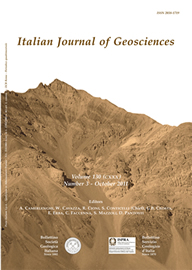
The Norian-Rhaetian interval in two sections of the Lagonegro area: the transition from carbonate to siliceous deposition
Nicola Giordano(*), Gloria Ciarapica(*), Angela Bertinelli(*) & Manuel Rigo(*)
(*) Nicola Giordano, Department of Earth Sciences, Università degli Studi di Perugia, Piazza Università, 1 - 06123 Perugia, Italy [nikgiordano@hotmail.it]; Gloria Ciarapica, Department of Earth Sciences, Università degli Studi di Perugia, Piazza Università, 1 - 06123 Perugia, Italy [ciarapic@unipg.it]; Angela Bertinelli, Department of Earth Sciences, Università degli Studi di Perugia, Piazza Università, 1 - 06123 Perugia, Italy [angela.bertinelli@unipg.it]; Manuel Rigo, Department of Geosciences, Università degli Studi di Padova, Via Gradenigo, 6 - 35135 Padova, Italy [manuel.rigo@unipd.it].
Volume: 130 (2011) f.3
Pages: 380-393
Abstract
New biostratigraphic data from two stratigraphic sections (Mt. St. Enoc and Mt. Volturino), of the Lagonegro Basin (Southern Apennines, Italy), define the age of the sedimentary events and delineate the sedimentary evolution for the Norian-Rhaetian time interval.
The upper part of the Calcari con Selce Fm in the Mt. St. Enoc section is characterized by an alternation of cherty limestones rich in organic matter and thin silicified calcarenites with black cherty layers. The upper part of the Calcari con Selce Fm of the Mt. Volturino section exhibits instead intermediate characters between the Calcari con Selce and Scisti Silicei Fms, with cherty limestones, shales and radiolaritic beds. The biostratigraphic data based on conodonts and radiolarians allowed a good correlation among the Norian-Rhaetian successions throughout the Lagonegro Basin the two sections represent two different environments of the Lagonegro Basin. In fact, radiolarites (Scisti Silicei Fm) are present from the Misikella hernsteini-Parvigondolella andrusovi conodont Zone (late Sevatian) in the Mt. Volturino section while they appeared after the Misikella ultima conodont Zone (uppermost Rhaetian) in the Mt. St. Enoc section. This proves that euxinic carbonate facies and radiolaritic facies were deposited in the same time interval and in the same basin. On the basis of sedimentological analysis and with the support of biostratigraphy, the non-coeval beginning of biosiliceous sedimentation is discussed in order to point out the control factors: different paleobatimetry, upwelling areas or volcanic activity. Our preliminary results show that the Lagonegro Basin during the Norian-Rhaetian interval was probably characterized by an articulated physiography and that volcanism should have had an important role in changing pelagic sedimentation.
Keywords
Norian-Rhaetian, radiolarians and conodonts, calcarenites, facies, Lagonegro Basin, Southern Apennines.
Get Full Text